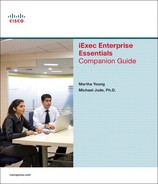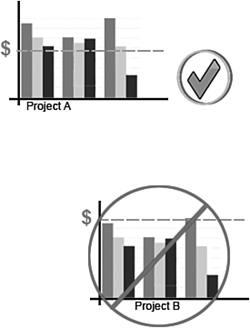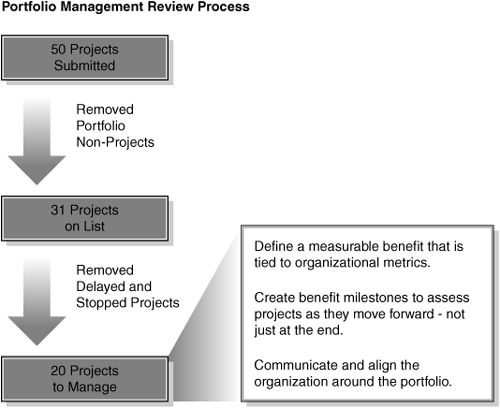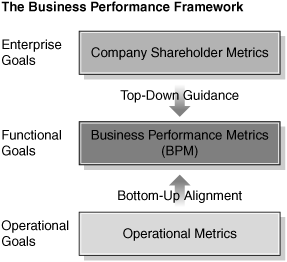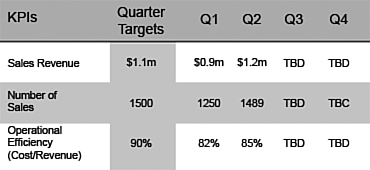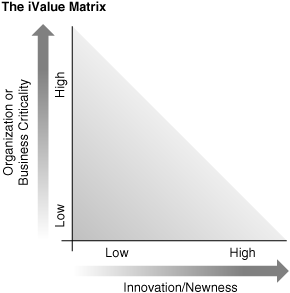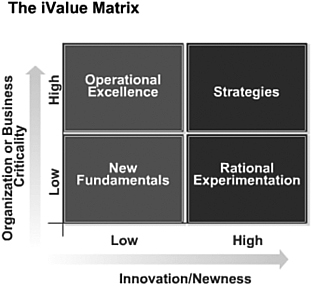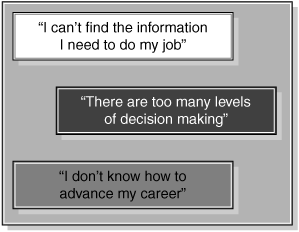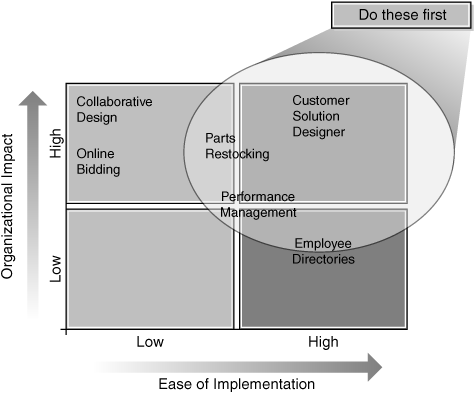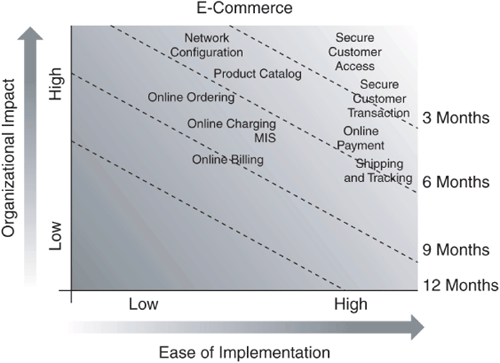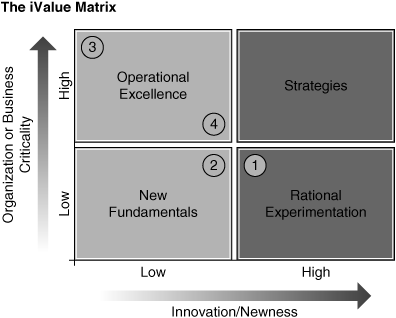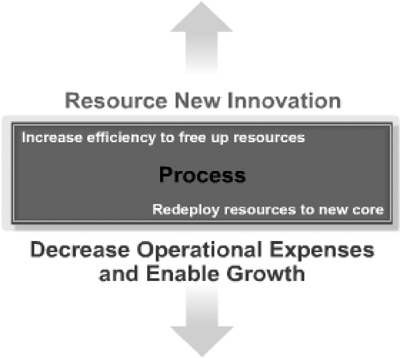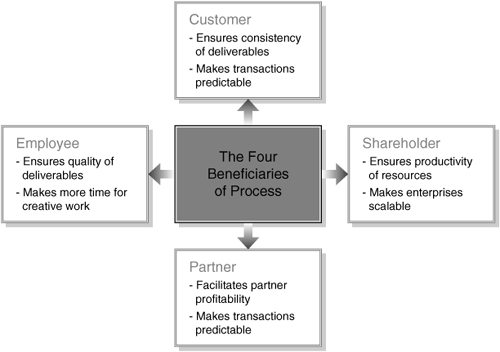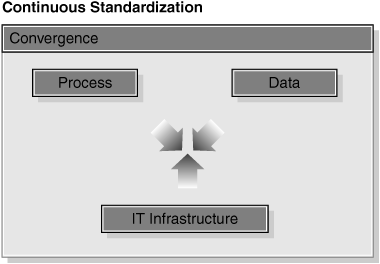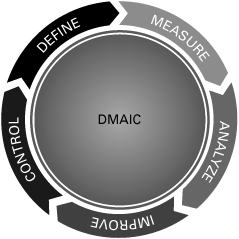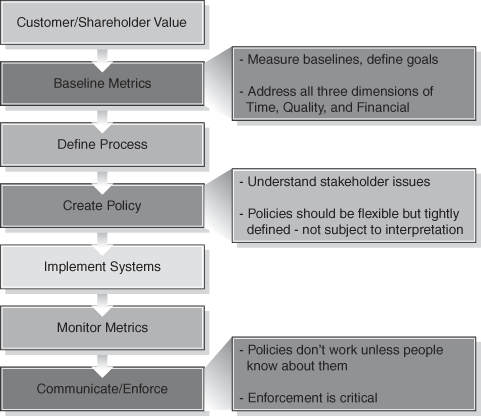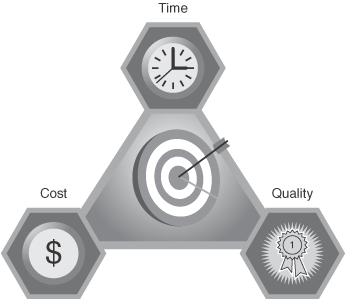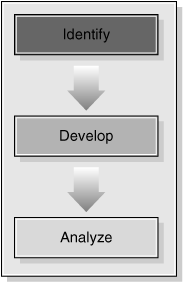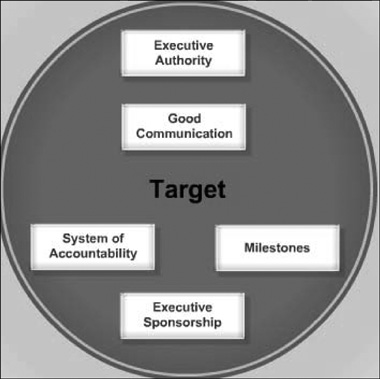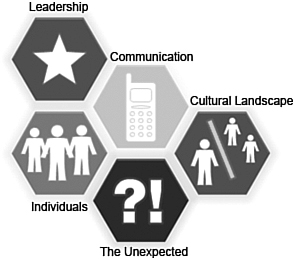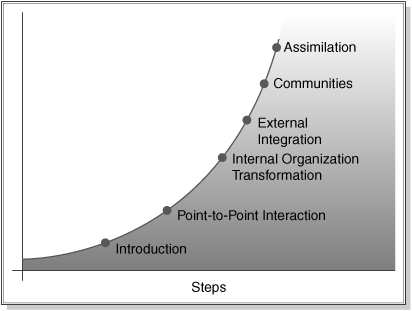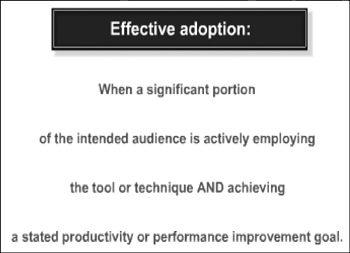To this point, you have seen the facilitative impact of information technology (IT), especially network-enabled IT, to effect massive improvements on business processes. This is all well and good, you are probably thinking, “But my IT assets are a mess! How can I even begin to apply additional technology when I might not be getting the maximum impact from the technology that I have already implemented?”
Do not feel bad: This situation is fairly typical, especially when the technology has grown up with the company or has been patched together due to mergers and acquisitions. Frequently, applications or tools are acquired for a single feature or function rather than the transformational benefits that can be had with more extensive implementations.
This is called the 10 percent rule. Generally, for any technology product, only about 10 percent of all the functionality is actually tapped. This can also be seen in consumer goods. Although few people use them this way, cell phones can store calendars, keep track of contacts, and act as calculators. This paradigm might be fine for consumer goods, but it can be destructive for businesses.
This is because, in business, it is important to inventory all assets and leverage them for maximum gain. When functionality is acquired or developed but not used, the impact acts as though a capital asset were acquired and allowed to rust in some backyard.
This section will discuss the strategies necessary to manage IT as a portfolio of tools that can be leveraged effectively. The discussion will extend to the ways in which the portfolio can be mapped to business processes to effect maximum change. In particular, it will discuss the importance of IT portfolio management, business process management, project life cycle management (PLM), change management, and adoption strategies.
As you will discover, successful organizations demonstrate these principles in three ways:
Process management imparts organization-wide standardization of processes, to control the way the organization runs.
PLM provides standards for project implementation.
Change management enables organizations to implement effective changes immediately, rather than lingering indefinitely in the planning phase.
Upon completion of this module, you should be able to do the following:
Apply the portfolio management approach to classify current initiatives.
Summarize the benefits and use of a project roadmap.
Recognize barriers and principles of project success.
Describe the five steps of the define, measure, analyze, improve, and control (DMAIC) method of business process management.
Describe the elements of PLM.
Arrange the steps of PLM.
Explain the change management principles.
Arrange the steps of change management.
Recognize adoption strategies.
Describe the phases of the adoption process.
As noted earlier, you must manage IT as any other asset in an organization. Chiefly, this means that you must manage IT as a portfolio of tools that can be brought to bear on business process issues. In particular, managing IT to achieve maximum impact requires evaluating each IT project in the context of the degree to which it can return value to the overall organization. From the standpoint of an IT portfolio, IT has many opportunities for adoption to improve processes. However, unlike a manufacturing tool that must be acquired from a third party, most businesses have the capability to develop their own IT tools.
This makes controlling the investment in such tools difficult, and because functions in existing tools might adequately address user needs, it becomes important to formalize the process of acquisition of information technology. One way to handle this is to adopt a formalized approach to the development and deployment of IT called IT portfolio management.
In this section, you will discover what portfolio management is, why it is important, and how to create a portfolio of potential IT initiatives.
By the end of this section, you will be able to do the following:
Explain the uses and value of portfolio management.
Explain the portfolio development process.
Define the principles for developing business performance metrics.
Evaluate current initiatives using the iValue matrix.
Identify new Internet and IT initiatives using value chain analysis, stakeholder analysis, and visioning.
Evaluate current and potential new IT initiatives.
Use the e-Portfolio Manager and the project prioritization matrix to identify and prioritize new initiatives.
Build a project roadmap.
Select attractive projects for further business case development.
Portfolio management might sound like something you would hear from a stockbroker. In fact, this notion is not too far off the mark. A stockbroker is charged with managing the money of his clients in a way that achieves the highest return possible. Just like a stockbroker, the IT organization is charged with maximizing the return to the company from its investment in IT. The way this is done is to treat the collection of IT projects and existing systems as a portfolio of investments that must be actively managed to ensure that the investments are in the correct areas and at the appropriate amounts of investment. Active portfolio management ensures that IT systems are being optimized within the company. It also monitors IT on a holistic basis, identifying specific areas where the company should increase, decrease, or drop systems and applications as necessary.
Portfolio management is one way to do that. The premise of portfolio management is that organizations have scarce time and resources and cannot afford to try every good idea that might result in a positive outcome.
The portfolio management approach recognizes that all organizations make a series of investments to achieve their goals. Portfolio management is the process and methodology for managing and optimizing the IT investments of an organization, thereby reducing duplication and increasing productivity across the entire enterprise. Figure 6-1 shows the consideration required for IT portfolio management.
Rather than the passive approach to IT project management that many organizations take, where IT investment is allowed to grow without too much thought to the actual return generated, portfolio management requires an active approach with an emphasis on company benefits, as shown in Figure 6-2. An active approach generates many benefits:
Organizations prioritize, allocate, and sequence resources. They also support good governance, allowing projects to be compared regularly based on performance measures.
Selected projects are aligned with organizational objectives and have the best trade-offs of cost, benefit, and risk. Projects that are underperforming can be eliminated to free up resources for better-performing or new projects.
Organizations focus on their priorities by working on the right project and the right number of projects, as loosely illustrated in Figure 6-3. At the end of this process, you will have a list of specific and prioritized initiatives to implement within your organization.
Within the strategy and portfolio planning process, the portfolio management approach described here will be used to evaluate current initiatives, identify new opportunities, and prioritize and select projects for business case development and implementation. The steps to achieve this are as follows:
Determine the metrics to use.
Review the current initiatives.
Identify new opportunities.
Prioritize new opportunities.
Select your initiatives.
Build a roadmap.
For now, it is important to note that the portfolio management process requires a formalized approach to IT initiative inventory and evaluation. This module explores each step in depth. It is important to note, though, that portfolio management is not just an exercise applied to new investment. It is also a way to evaluate existing investments on a continuous basis. Many companies forget that IT, like any other investment, can deliver less than expected results that might require deinvesting in a particular technology.
By implementing a portfolio management review process, similar to the flow in Figure 6-4, your organization can define a measurable benefit that is tied to organizational metrics. This process allows you to create benefit milestones to assess projects as they move forward—not just at the end of the project. It also enables you to communicate and align your organization around the portfolio.
Portfolio management is an effective way to remove duplicate or unapproved projects and projects that have become delayed or stopped since the previous review. The benefits of this process are lower cost, fewer projects to manage, and improved success rates on remaining projects.
What are metrics? Metric is a term that has achieved overuse in recent years. As a concept, it is actually pretty straightforward. A metric is a measurement of something. It can be either qualitative or quantitative in nature, although for the purpose of statistical analysis, it is better if it is quantitative. The problem with metric as a term is that it takes a simple concept and wraps it in technical jargon that can be hard to communicate to decision makers, who might not be as technically inclined. When using metrics, it is important that each measure should be explainable to nontechnical personnel in terms they understand.
Regardless of the metrics chosen, the portfolio management approach needs to align IT to the goals of your organization. To achieve this, you can adopt several categories of metrics. The business performance framework, illustrated in Figure 6-5, enables a firm to map project performance metrics against enterprise, functional, and operational goals.
These are top-line measures that determine shareholder value and drive enterprise goals. For-profit businesses determine shareholder value by factors such as revenue growth, market share growth, margins, and operating expenses.
These are measurements of business functions that apply across the entire organization. Business performance metrics (BPM) include increased employee productivity, higher customer satisfaction, increased revenue, reduced days of inventory, and reduced employee turnover.
A key challenge for organizations is to bring all three levels of metrics into alignment. For example, operational metrics should measure and align with key performance indicators (KPI) to determine the success of the IT project and provide insight into factors driving business performance. Figure 6-6 shows top-down and bottom-up alignment flows.
The senior management team must create specific business measurements to ensure that all activities match enterprise goals.
Business managers must define the metrics of their projects. In addition, operations should conform to the business performance metrics.
The importance of reconciling top-down guidance with bottom-up alignment cannot be overstressed. When this exercise is never really accomplished, the misalignment of expectations can be enough to cause the company to fail. When those who are paying for initiatives are not in agreement with those who are implementing them, projects can fail in spectacular ways.
KPIs are another poorly understood concept. Although a KPI ought to be well defined, as a little thought will reveal, the term incorporates a fair amount of ambiguity. What makes one metric more important than any other? It is only in the context of business goals that the concept of “key” becomes understandable.
A well-known management principle is “You cannot manage what you do not measure.” Key performance indicators are critical to any business process improvement initiative. KPIs, then, become the specific measurable indicators that report progress toward organizational goals and objectives. They evaluate the critical success factors of your organization that are defined within the framework of the goals and objectives of the overall business, enabling management to measure improvements and take action. For example, KPIs for sales might include average discount by region, average sales by salesperson, or average order size. Figure 6-7 illustrates another, yet different set of sales KPIs.
So, to recap, metrics are important for the following reasons:
Managers use metrics to compare the value of different projects to determine their relative priority in portfolio reviews.
Metrics enable near real-time reaction changes.
Metrics provide a standard reporting format across all measures, resulting in consistency of information.
Metrics improve productivity by enabling managers to measure and manage performance.
Standard reporting of metrics allows managers to focus on business analysis.
At the operational level, you can use metrics to communicate progress and success.
On the following blank page, using the Business Performance Framework, write down the key metrics used in your organization to measure business performance.
___________________________________________________ ___________________________________________________ ___________________________________________________ ___________________________________________________ ___________________________________________________ ___________________________________________________ ___________________________________________________ ___________________________________________________ ___________________________________________________ ___________________________________________________ ___________________________________________________ ___________________________________________________ ___________________________________________________ ___________________________________________________ ___________________________________________________ ___________________________________________________ ___________________________________________________ ___________________________________________________ ___________________________________________________ ___________________________________________________ ___________________________________________________ ___________________________________________________ ___________________________________________________ ___________________________________________________ ___________________________________________________ ___________________________________________________ ___________________________________________________ ___________________________________________________ ___________________________________________________ ___________________________________________________ ___________________________________________________ ___________________________________________________ ___________________________________________________ ___________________________________________________ ___________________________________________________ ___________________________________________________ ___________________________________________________ ___________________________________________________ ___________________________________________________ ___________________________________________________ ___________________________________________________ ___________________________________________________ ___________________________________________________ |
The next step in portfolio management is to review the current initiatives. As noted earlier, this is important because if you do not understand what you are already doing, you cannot evaluate what you want to do. One way to do this is to use the iValue matrix.
The iValue matrix is a concept that was introduced in 2000 in a book by Amir Hartman and John Sifonis: Net Ready (2000, McGraw-Hill), to provide a tool for use in prioritizing IT projects. As illustrated in Figure 6-8, each quadrant of the iValue matrix represents a different balance of innovation or newness and organizational criticality. Although somewhat subjective, the tool nevertheless provides a compelling way to evaluate projects in relation to each other. The two dimensions used for evaluation are organization or business criticality on the Y-axis and innovation/newness on the X-axis:
Organization or business criticality: These initiatives are typically focused on productivity and profitability. They answer the question: Are the initiatives delivering cost reductions or improved efficiency?
Innovation/newness: Are the initiatives new or innovative compared to others in the marketplace? Initiatives that have a high degree of innovation/newness are typically focused on competitive differentiation and growth.
Use the iValue matrix to review your current IT initiatives to see if they are aligned with the strategic objectives of your organization. Some examples of IT initiatives applied to the iValue Matrix are illustrated in Figure 6-9. To plot your initiatives on the matrix, you need to ask the following questions:
Are these initiatives driving sufficient value for your organization?
What is the nature of your initiatives? Are they driving the following:
New value creation
Innovation and growth
Cost reduction
Productivity and efficiency
Are the initiatives misaligned with your objectives? Should they be replaced?
On this and the following blank page, write an IT initiative used or that could be used in your organization. List at least one for each of the four quadrants of the iValue matrix.
___________________________________________________ ___________________________________________________ ___________________________________________________ ___________________________________________________ ___________________________________________________ ___________________________________________________ ___________________________________________________ ___________________________________________________ ___________________________________________________ ___________________________________________________ ___________________________________________________ ___________________________________________________ ___________________________________________________ ___________________________________________________ ___________________________________________________ ___________________________________________________ ___________________________________________________ ___________________________________________________ ___________________________________________________ ___________________________________________________ ___________________________________________________ ___________________________________________________ ___________________________________________________ ___________________________________________________ ___________________________________________________ ___________________________________________________ ___________________________________________________ ___________________________________________________ ___________________________________________________ ___________________________________________________ ___________________________________________________ ___________________________________________________ ___________________________________________________ ___________________________________________________ ___________________________________________________ ___________________________________________________ ___________________________________________________ ___________________________________________________ ___________________________________________________ ___________________________________________________ ___________________________________________________ ___________________________________________________ ___________________________________________________ |
After prioritizing existing projects, portfolio management examines new opportunities that the existing portfolio might not be addressing, or might not be addressing effectively. As noted previously, this is usually the place where many organizations start; however, without the baseline established through an examination of existing initiatives, this step can lead to significant conflicts between existing projects and new ones. In fact, without a recognition of the importance of existing initiatives, this step can introduce organizational in-fighting and reduced morale.
In this phase, you identify opportunities for new initiatives that are aligned with the vision, goals, and objectives of your organization. Two approaches that you can use are to conduct a value chain and stakeholder analysis. An Organization value chain is shown in Figure 6-10.
Typically, opportunities for IT projects are found when looking for friction points or unaddressed frustrations that exist in the value chain of an organization. As discussed previously, the value chain is the process by which raw materials are converted into products and services that the user or customer values enough to purchase. After you have identified stakeholder frustrations or friction points, you can look for Internet-enabled solutions to these problems.
Value chain analysis begins with a review of the strategic objectives of the organization. What should the organization do for itself versus outsource? What are the core functions of the organization? Typically, the answer to such questions quickly reveals the key tasks on the value chain. Figure 6-11 offers some examples of core functions.
Armed with the core functions, ask what opportunities and threats are implicit in the core skills. In other words, who could do these things better than your organization: outsourcers, out-taskers, competitors? What could you do better in the context of the skills that the firm already possesses? Can operations be improved?
Finally, value analysis asks what opportunities or threats could be addressed by the application of Internet-enabled IT. If this is done, what would success look like? How can the metrics developed during the portfolio analysis process be applied to determine success?
Which parts of your value chain will likely have the greatest impact on the needs of your organization? For example, if the focus is on growth, you might want to look at sales, marketing, and product development. If the focus is on cost reduction, you might want to look at areas that account for a high percentage of your operating expenses.
Remember to define opportunities in terms of the key stakeholders for each task in the value chain. Otherwise, organizational resistance can quickly negate any changes that could be implemented. Sun Microsystems, as an example, uses an approach called CAP (Change Acceleration Process) to identify key stakeholders and ensure that their needs are met when applying process improvement. At the very least, take the following steps to ensure that key stakeholders are included in value analysis:
Identify the major stakeholders involved in a select function of the value chain. For example, for sales, it might include customers, distributors, resellers, sales managers and sales representatives, order processing, and finance.
Through interviews or workshops, explore the wants, needs, and expectations of the stakeholders. For each of these stakeholders, find out what makes it difficult for them to perform their job quickly and effectively. Are friction points or broken or manual processes causing errors, delays, or dissatisfaction? Figure 6-12 provides a few common stakeholder questions.
Take your list of problems or issues and think about how Internet or IT-enabled business processes might be used to solve the problems. List at least one or two possible solutions for each problem, with the benefits.
On this and the following blank page, select an area of your organization. Identify the key stakeholders, and list five or six frustrations or friction points. Pick the top two frustrations and identify possible solutions.
___________________________________________________ ___________________________________________________ ___________________________________________________ ___________________________________________________ ___________________________________________________ ___________________________________________________ ___________________________________________________ ___________________________________________________ ___________________________________________________ ___________________________________________________ ___________________________________________________ ___________________________________________________ ___________________________________________________ ___________________________________________________ ___________________________________________________ ___________________________________________________ ___________________________________________________ ___________________________________________________ ___________________________________________________ ___________________________________________________ ___________________________________________________ ___________________________________________________ ___________________________________________________ ___________________________________________________ ___________________________________________________ ___________________________________________________ ___________________________________________________ ___________________________________________________ ___________________________________________________ ___________________________________________________ ___________________________________________________ ___________________________________________________ ___________________________________________________ ___________________________________________________ ___________________________________________________ ___________________________________________________ ___________________________________________________ ___________________________________________________ ___________________________________________________ ___________________________________________________ ___________________________________________________ ___________________________________________________ ___________________________________________________ ___________________________________________________ ___________________________________________________ ___________________________________________________ |
With the completion of the value analysis, you should have a pretty good idea of the opportunities for improvement on which IT can deliver. You probably have a list of potential IT projects that you could undertake to achieve process improvement. So, how do you select the ones that will actually be done? One way that you could use to select the best projects to undertake is the Project Prioritization matrix.
The Project Prioritization matrix, shown in Figure 6-13, is similar to the iValue matrix, and with good reason: The Project Prioritization matrix (PPM) was developed by the same authors (Amir Hartman and John Sifonis) who developed the iValue matrix. The PPM allows you to see projects in relation to each other based on two dimensions: organizational impact and ease of implementation.
Organizational impact assesses the business value of the initiative to the organization. You can measure organizational impact in a variety of ways, including return on investment (ROI), customer satisfaction, cultural impact, and the cost of not implementing the initiative (lost opportunity).
Ease of implementation (and adoption) refers to the degree of difficulty to implement the initiative and gain adoption. This dimension considers a variety of factors, including project cost, complexity, process change required, availability of skilled resources, availability of systems and data, likely rate of adoption, and training and support needs.
Your project portfolio selections are often a trade-off between these two factors. Your choices should be based on a combination of factors, including these:
Cost and benefit
Complexity and risk
After completing the PPM exercise, you now have a list of potential projects, each of which will improve the delivery of value to customers and each of which is acceptable to key stakeholders. How do you decide which ones to do? Generally, projects that can be delivered quickly with measurable benefits provide faster results and lower risk. Because some important projects might also be large and complex, consider breaking these projects into phases that can be delivered rapidly. Figure 6-14 maps the smaller components of a large E-Commerce Initiative against business value and ease of implementation.
Always try to keep projects short and simple with small development and management teams. As the project length and scope increases, so does the risk of failure.
Another important point, which we addressed in our previous books on virtual business processes, is the idea of incrementalization. Incrementalization means that small projects that can deliver measurable returns will pave the way for additional similar sized projects. If each provides a benefit, the organization can often achieve true transformation without the risk and complexity of attempting to change things all at once.
As you select projects, keep in mind that without executive sponsorship, a project will likely fail even if all the other stakeholders are satisfied. The Sun CAP approach seeks to identify an executive sponsor early in the process of project selection.
To identify and select the IT initiatives that you can implement quickly and easily, you need to involve both business leaders and IT professionals. Your IT department or an IT consultant can help you scope and plan projects.
In addition, you need the following people:
Business manager: This is someone who understands the business processes and the business requirements of the project.
IT manager or consultant: This is someone who understands technology and who can help to specify the technical requirements.
Developing business strategies for IT initiatives requires that business and IT managers work together as a team.
Through collaboration between the business and IT, you can develop a project roadmap by plotting initiatives quarterly over a 15-month timeline. The example in Figure 6-15 shows that the quick wins are addressed first, followed by more complex projects. It bears noting, though, that sometimes complex projects will be undertaken first, as a basis for more transformation undertakings. When this is done, try to break down the larger projects into phases with deliverables scheduled at three-month intervals. This assures that your organization receives benefits from the initiative throughout its development, not just at the end.
Follow the larger projects with complementary projects that can be delivered in subsequent quarters. Finally, review your project roadmap quarterly to ensure that priorities have not changed. This will naturally occur when your firm follows the Project Prioritization matrix quarterly review and assessment.
In Module 5, “Strategy Development,” Oasis completed a strengths, weaknesses, opportunities, and threats (SWOT) analysis of its business. This analysis identified four possible initiatives that can create competitive advantage or minimize the weaknesses that Oasis identified within its business.
Oasis would like to take these initiatives one step further by applying them to the iValue matrix and building a project roadmap.
Following are the four possible initiatives identified in Module 5:
Create a web portal that allows businesses to mix and match office furniture combinations.
Create a website that promotes the high-quality products available to differentiate them from the bulk products offered by the large chain.
Offer an online order tracking tool for customers to track their orders to retain customer loyalty.
Provide an online listing of inventory available for immediate delivery.
Oasis has reviewed the suggestions and decided that the initiatives fit within the following iValue matrix quadrants shown in Figure 6-16.
Based on the iValue analysis, Oasis has decided that initiatives 1 and 4 align best with the strategic objectives of its business.
Oasis knows that both of these are large undertakings for its business and, as such, it has decided to develop a project roadmap. The project roadmap will enable it to better identify benefits to be received through the life of the projects. The roadmap might also help identify quick wins, which can enable some of those benefits to be realized earlier.
This project roadmap will give Oasis a better understanding of how these two initiatives could be implemented in smaller, manageable milestones. Oasis has looked at how these two initiatives might be implemented over time. This will also enable accurate measurement of the progress of the projects.
2 Months | 4 Months | 6 Months | |
|---|---|---|---|
Mix–and-match web portal | Design portal | Upload all stock options | Roll out to customers |
Online inventory availability | Design website | Promote with current and potential customers |
As you can see, armed with relatively simple tools, you can develop an IT portfolio and use it as a basis for analyzing a value chain and then building a project roadmap. Remember that this process is not a one-time exercise. It is a process that constantly evaluates the opportunities for process improvement. The danger is that projects that slip will quickly be overtaken by new opportunities and new projects. That is why having a plan for incrementalization is important to achieve continued success and measurable benefits rooted in the goals and objectives of the firm.
In this section, you will examine what a business process is, why it is important, and what the key considerations are for implementing business process management in your organization.
You will investigate two things:
The value of business process management
The DMAIC method of business process management
Business process management has become a central focus for automation in the past couple of years. The reason for this has to do with the sophistication that IT has achieved by integrating technology into the business. A few years ago, IT management technology was concerned with the management of networked applications. It was not long before business leaders noticed that this kind of infrastructure management could also be applied to the management of business processes. At that point, infrastructure management systems began to become aware of the business process.
Automation of business process management is only possible, of course, if business processes can be rationalized and managed in a formal way. Although you can address business process management in several ways, this section looks at it in a way that is consistent with Six Sigma process improvement approaches. This will include a review of business process management principles and will apply a Six Sigma approach called DMAIC to the analysis and improvement of such processes.
BPM provides the ability to gain visibility and control over information flows or transactions that span multiple applications and people, in one or more organizations. BPM consists of people, processes, and technology, which are combined to enhance the value of business processes throughout an extended enterprise or organization.
As W. Edwards Deming discovered during World War II, standardizing BPM promotes quality, improves productivity, lowers costs, and frees up resources to focus on innovation and value. It also unifies the focus of the organization, whether the focus is on creating profit, monitoring and fulfilling consumer needs, or growing the business.
BPM provides benefits for all the stakeholders of an organization, as shown in Figure 6-17. Process reengineering should always be done with the customer as the primary focus. Figure 6-18 shows the four beneficiaries of Process Management. Here the critical benefits are consistency and predictability:
For partners: BPM streamlines transactions and makes them more predictable, improving partner profitability and loyalty.
For shareholders: Efficient processes drive productivity for growth and lower costs, or they provide better profitability and greater leverage of existing resources.
For employees: Well-designed processes help ensure efficiency and quality in the work of employees, and they free up more time for employees to pursue more creative work.
One of the key strategies of networked virtual organizations (NVO) is to continuously standardize business processes, data, and IT infrastructure both inside and outside the organization. For example, some companies might have different ways of handling customer orders depending on whether the orders came in over the web, over the phone, in the mail, or in a store.
This creates an inconsistent customer experience, which can negatively affect customer satisfaction and repeat business. That inconsistency also makes it difficult for the company to quickly gauge customer response to new items or sale prices, thus making it next to impossible to create a just-in-time inventory management system run by the company suppliers.
As can be seen in Figure 6-19, BPM provides a context in which to evaluate the impact of Internet-enabled IT projects. Does the project improve the quality of the outcome? Can you actually measure the impact in a statistically meaningful way?
The focus on measuring the outcome of BPM led to the development of formalistic approaches to BPM that depend on metrics. One of these is called DMAIC.
DMAIC is an acronym that describes the five steps of BPM:
Define
Measure
Analyze
Improve
Control
DMAIC is a term that has come into widespread adoption through the auspices of the Six Sigma statistical quality analysis approach. Organizations utilize DMAIC for BPM when a process is not performing well and the causes of the process problem and its solution are not well understood.
To improve processes, you must first evaluate and measure them by profiling any important and poorly performing processes. Processes that have established KPIs are often better candidates for improvement because they can be measured before and after the process improvement implementation.
As can be seen from Figures 6-20 and 6-21, you can think of DMAIC as a continuum of steps that flow into each other. The process is actually circular rather than linear, in the sense that after an improvement is made, it is subject to evaluation and further improvement. The DMAIC steps include the following concepts and should answer the following questions.
Define the problem and its scope from the customer view, and evaluate the cost versus the benefit of fixing it.
What is the problem, and is it worth fixing?
What is the scope of the process and the problem?
Measure how the process is currently performing. Collect past and present data about the process so that you understand the problem better.
How is the process performing right now?
What portions of the processes require closer analysis?
Analyze the causes of missed process performance by distilling the collected data. Determine the source (the root causes) of the problem.
What are the root causes of the problem?
Do you know enough to formulate a solution?
Improve the process to address the identified causes. Evaluate solutions for customer and organizational impact, implement worthy solutions, and monitor results.
What is the best way to fix the problem?
What are the consequences of this solution for all processes?
Improve the process to address the identified causes. Evaluate solutions for customer and organization impact, implement worthy solutions, and monitor results.
What is the best way to fix the problem?
What are the consequences of this solution for all processes?
Control (monitor and adjust) the process to sustain the improvements. Confirm the continuing effectiveness of the solutions, and document the date for future uses.
Is reporting in place to confirm the effectiveness of the solution?
How can you sustain the solution?
When looking for process improvement opportunities, start by defining the value for the customer and the stakeholder. Set clear goals that measure the time, quality, and financial impact before you define the process.
After defining the process, establish the policies and procedures that consider customer and stakeholder issues. Where possible, policies should be flexible to accommodate how people like to work but should be well defined and not subject to interpretation.
Finally, after implementing systems and measurement systems, inform and educate the stakeholders about the new process, its benefits to the organization, and its benefits to them. Stakeholders should also know about the policies and how they will be enforced.
BPM, using a DMAIC approach, is a powerful way to implement a process of continuous improvement, as shown in Figure 6-22. Companies like Cisco have successfully used DMAIC to radically speed up the development and improvement of technology. Of course, the entire process improvement cycle depends on being able to implement changes quickly and effectively. Although the BPM approach defines where such implementation needs to take place, it has little to say about how such implementation can be done effectively. This is the domain of the project life cycle, discussed next.
This section examines a few common barriers to successful project execution and introduces concepts that are crucial to it. You will learn about the following:
Project management and why it matters
Barriers and enablers of project success
PLM elements and steps
PLM is an approach to IT project implementation that recognizes that any IT project has common steps that must be accomplished before the project can be successful. Figure 6-23 shows the three core metrics of PLM. It incorporates a formalized approach to project management that includes a significant amount of oversight. It is the extensive oversight requirement of PLM that has been criticized as being so cumbersome that it slows down implementation.
Nevertheless, as you will see, the formalization that PLM brings to the implementation process can ensure success to complex projects. In fact, the recognition of this capability has led to its adoption within the ISO 9000 standards for quality certification.
Project life cycle management begins and ends with project management. Project management is the application of knowledge, skills, tools, and techniques to promote activities to meet the project requirements. As shown in Figure 6-24, project management is a proven discipline used to deliver consistent, predictable, and repeatable results by doing the following:
Identifying and following the progress of milestones and deliverables
Developing cost estimates based on a timeline
Analyzing the effects of change, and incorporating those results into the planning process
Success with project management should guarantee that the selected technology works, the business problem is solved, and the investment is contained. PLM resolves one of the major issues of project failure: scope creep. By clearly defining a project, its timeline, and its deliverables, you eliminate scope creep from the beginning.
As IT budgets continue to rise as a percentage of overall spending, organizations are under great pressure to manage risk and budget. In 2003, the Standish Group found that only 34 percent of the projects that were evaluated succeeded, and most failures were caused by poor project management. However, the most critical skills required for effectively managing a project are not always apparent or developed in an organization. A project management discipline is needed to develop most critical skills required for effectively managing a project.
The objective of developing this discipline is to provide the end-to-end project delivery and project management processes, standards, best practices, and tools to enable the organization to achieve higher levels of performance and organizational impact.
As noted earlier, formalized project management has a relatively poor record for success. In the context of IT, this is understandable. IT evolves so quickly that, if a project is longer than about six months, technology improvements begin to erode the value delivered by the project. The expectations of executives and other stakeholders, which are set not by the project but by what the market is doing, begin to either add requirements or withdraw support. This is why project management bodies such as the Project Management Institute (PMI) are actively seeking to redefine project management processes for IT.
In addition to the extreme sensitivity of IT projects to the timeline, there are other barriers to success for such projects as noted below and shown in Figure 6-25. The barriers to project success rise from many sources, but the organizations themselves often create obstacles.
The most common barriers to project success are these:
Unclear and unmeasured business value: Funded projects are selected without a clear business case, defined metrics, or measurement strategy. IT project portfolios are not actively reviewed and revised.
Poor governance processes: Roles and responsibilities of business and IT project members and stakeholders are not well defined. Neither side is mutually accountable for project success; commitments are not met.
Poor communication: Weak communication among project team members, sponsors, and stakeholders leads to conflicting goals and schedules.
Cost overruns: Inadequate budgeting, poor financial controls, and lack of contingency planning result in cost overruns.
Time overrun: Without executive sponsorship and leadership involvement, project management schedules are often not actively tracked.
Scope growth: Projects lacking short-term deliverables and interim milestones often incur extended scope due to overdesign and poor accountability.
Of course, you should not take any of this as an indictment of IT project management. Although only about 34 percent of projects achieve true success, it is still true that IT projects are virtually impossible without some form of project management. The key is to understand, up front, that IT projects that are seeking to achieve a transformation of any part of the organization are likely to be hard to do. Rather than drop such projects, it is better to focus on those things that can promote project success within the context of sound project management.
The good news is that you can do many things to ensure project success. Many of these principles for project success, shown in Figure 6-26 as well as noted here, directly address the barriers to success:
System of accountability: Team members and sponsors must have defined roles and responsibilities and be accountable individually and collectively.
Good communication: Regular communication between the project team and sponsors is crucial. Communication strategies are needed to build awareness and interest by the key stakeholders.
Executive sponsorship: Executive sponsorship is crucial for securing cooperation for the project throughout the organization.
Executive authority: Someone must be in the position to make decisions about the project. This person must have the ability and willingness to end the project at any stage if it fails to meet agreed milestones, budget, or performance targets.
Milestones: Any project should have both short-term and long-term milestones with specific deliverables. These milestones must be actively measured and monitored.
So, with project management as a basis for discussion, you can now answer the question of how this relates to the idea of project life cycle management and how project life cycle management can ensure the success of Internet-enabled IT applied to business processes.
Project life cycle management provides guidelines for project implementation and ongoing maintenance. Although BPM provides oversights for the processes of an organization, project life cycle management guides the implementation of solutions in the improve phase of the DMAIC method of process management. By utilizing project life cycle management, organizations manage the implementation of the project from the conceptual phase to the maintenance phase to ensure the delivery of quality results, as illustrated in Figure 6-27. For example, project life cycle management ensures that IT initiatives will be implemented effectively with technical standards, timely delivery, and correct organization integration.
A key benefit of project life cycle management is that it ensures projects are reviewed at intermediate points, called milestones. These help confirm that projects remain in scope and are aligned with the objectives and standards of the organization.
There is a caution here, though. As you have seen, process and review are no substitute for execution. Many organizations lose sight of the fact that formalization and management, although generating substantial activity, frequently mask the fact that nothing much is happening in the project. When the project manager begins to report missed deadlines and the number of meetings is increasing within a project, those are signs that the project life cycle is focusing on process rather than execution.
The project life cycle, though, is conceptually pretty simple. It begins with an assess and identify step, where a value chain assessment leads to the identification of opportunities for an IT project. Following this, the proposed project is analyzed in terms of its probable impact and success.
At this point, a project is given a go or no-go by key stakeholders, and the project moves to the design stage, where the solution is developed. After this, the solution is built, tested, and implemented. When the solution is in place, it moves into a support and maintain status.
At each stage of the life cycle is a point where governance is brought to bear to review the progress and provide authorization for advancement to the next step.
Although this describes the standard project life cycle, in recent years an additional step has become common. This is one associated with retirement of the project. As technology ages, its impact may lessen. Recognizing this, many companies now periodically review existing projects to determine if they should be phased out.
As the previous section indicates, managing an IT portfolio can be complex. One of the principal drivers of complexity is the rate of change that technology forces upon an organization. Change has been the topic of many books, not the least being books by Tom Peters about thriving on chaos, which seemed to launch the genre. However, in spite of the transformational impact of change, it can also be extremely disruptive.
Unfortunately, most IT projects, at their heart, are about change. Any new technology is likely to force people out of their comfort zone. This threatens most people and typically generates resistance, either overt or covert. Many projects have failed simply because employees, customers, or key stakeholders opposed them. Consequently, learning to manage the process of change can be critical to the success of IT projects.
In this section, you will explore the following:
Different approaches and key principles of change management
Steps to create a change management program
Phases of a continual adoption planning process
Change management is an organized, systematic application of the knowledge, tools, and resources of change that provides organizations with a key process and incentives to achieve their business strategy. As it relates to new, Internet-enabled business process, change management includes the following activities:
Developing a business case for change
Assessing the organizational readiness for change
Addressing stakeholder issues, concerns, and possible resistance to change
Developing a change management plan
Identifying change agents, and defining their roles
Developing a communication strategy plan
Creating a reinforcing change process
Managing the challenges that arise in initiating and sustaining change
Organizations cannot properly formulate the steps to successful change without understanding the key principles driving effective change management. Figure 6-28 illustrates some of the principles of change management.
Although they are not exhaustive, the following are some of these principles:
Leadership: Effective change management starts at the executive level.
Individuals: All employees will have personal concerns about the changes. Organizations should address these concerns formally through official organization channels to present a unified and consistent message. However, leaders at each level should prepare to allay the specific concerns of individual employees.
Communication: Often people in an organization either do not understand the need for change or misunderstand it; therefore, providing clear explanations of the change and its benefits is crucial. Organizations can reinforce core messages periodically so that employees can access the correct information about the change and provide appropriate responses.
The unexpected: Organizations should prepare for people to react in unexpected ways. By continually reassessing the impact of the change and the willingness of employees to adopt further changes, organizations can make the necessary adjustments to maintain successful change.
Cultural landscape: Every organization is unique and promotes a different cultural landscape composed of the attitudes, values, and practices of its employees. Organizations must assess the cultural landscape and directly address any conflicts with the change. An organization should also consider how it can use its cultural landscape to promote the change, such as through incentives.
Of these, probably the most important principle is the first one: leadership. Effective change must have sponsorship from the leadership of an organization. If leaders do not explicitly and openly support a change, it is unlikely that anyone else in the organization will.
Many organizations have track records of “the next big thing.” This is a dynamic where once a year the leader announces a new initiative. It involves a flurry of activity in which many teams are formed to implement the new initiative, with numerous executive speeches and workshops. Ultimately, the noise dies down and the initiative is forgotten. By the end of the year, no one remembers what it was. Such business practices can be destructive, eat up resources, and ultimately drive morale and productivity into the ground. If leaders are not willing to support a change and continue to do so, it is better not to attempt it, because it will fail.
A successful change management program will occur over several phases and several years. As such, these steps might be different depending on the organization and the scope of the change. Figure 6-29 illustrates the basic steps of a change management program.
These steps are explained next:
Introduction: Introduce the new technology through a static medium.
Point-to-point interaction: Utilize the technology to create a basic interaction that is usually limited to two points, such as between the organization and a customer, between the organization and a supplier, or between the organization and an employee.
Internal organization transformation: Redesign the organizational processes to integrate with a common IT infrastructure.
External integration: Integrate the network beyond the organization to manufacturers, suppliers, or other business associates.
Communities: Use technology to create e-hubs, exchanges, or communities of interests.
Assimilation: Assess and adjust the technology change as necessary, remembering that the technology and the organization are inseparable.
By planning change management in steps according to key principles, an organization can make adjustments in response to how well its stakeholders are embracing the changes. An organization can additionally revise its change management plan to utilize new and improved technologies.
Although organizations might implement new technologies, applications, and processes, these things will provide no benefits to the organization unless they are widely adopted and used. Change management must ultimately concern itself with adoption of a technology. As noted previously, this starts with the leader; however, a successful adoption strategy requires not only executive support, but strong leadership and organizational priority. In all cases, a successful strategy must effectively communicate the benefits of adoption. As defined in Figure 6-30, effective adoption exists when a significant portion of the target audience is actively employing the tool or technique and achieving agreed-upon goals and measures.
Adoption strategies are an important part of change management to drive acceptance and the use of new initiatives. They typically include pilot tests, training, education, marketing, and communications.
Organizations achieve effective adoption through a continuous adoption planning process that entails an unending cycle with four phases:
Formulating adoption goals include determining user requirements, planning necessary resources, and creating success criteria such as, “95 percent of the target audience should be using the tools within six months.”
Developing an adoption plan involves adoption pilots, training, communications, and feedback mechanisms.
Implementing the adoption requires production support such as training teams and the ability to adjust according to feedback.
Measuring the results utilizes the success criteria created in the formulating adoption goals phase to evaluate the effectiveness of the adoption. This phase informs the next phase for formulation of new adoption goals.
By utilizing a continuous adoption planning process, illustrated in Figure 6-31, organizations can effectively deploy their resources.
As you can see, just as in constant improvement and project life cycle planning, change management involves a constant adoption cycle where adoption goals are set and evaluated. As adoption proceeds, the metrics used give important clues not only to the success of change, but also to problems with the technology that can be addressed in other parts of the project life cycle.
As you have seen in this module, process is an important part of IT implementation. Although too much process can be anathema to creativity, an effective application of process can be an important part of adopting technology, making changes to organizations, and meeting competitive threats in the marketplace. Following are important concepts you have reviewed:
The phases of an organizational transition to a process-oriented focus
The challenges and principles of project success
The value, elements, and steps of project life cycle management
The principles behind implementing and managing a successful business process for your IT initiatives
The DMAIC method of business process management
The importance of approaches, principles, and steps of change management
The importance of adoption strategies, and the phases of the adoption process
Each of these concepts provides tools you can use to incrementally implement transformational Internet-enabled IT to virtualize a business and radically improve its performance.
